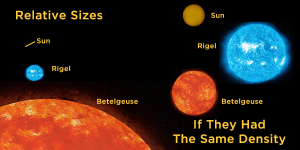Blog
Red Hot Vacuum
19 May 2015
 Brian Koberlein
Brian KoberleinOne of the common tropes in astronomy is a comparison of our Sun to other stars. It’s a great way of showing just how tiny we are. Betelgeuse, for example, has a radius more than 1,100 times that of the Sun. In an image comparing stars, our Sun is easily reduced to a tiny pixel among giants. But such an image is also a bit misleading. While the relative sizes of these images are typically accurate, they ignore the more important aspect of a star, which is its mass.
Since Betelgeuse has a radius 1,100 times that of the Sun, it has a volume about 1.3 billion times larger than the Sun. But its mass is only about 8 – 20 times the Sun. This means the density of Betelgeuse is much, much lower than the Sun. The density of a star isn’t uniform, and increases with depth, but very roughly the average density of the Sun is about 1.4 grams/cc, or about 1.4 times the density of water. That might not seem like much, but it’s pretty high for an object that is mostly hydrogen and helium. The average density of Betelgeuse is about 12 billionths of a gram/cc, which is about a million times less dense than Earth’s atmosphere at sea level. That’s about the same as a vacuum found in an insulating Thermos bottle.
Basically, a star like Betelgeuse is a red hot vacuum.
You might think that such a hot, low-density star isn’t sustainable long term, and you’d be right. Betelgeuse is in its red giant stage, where it makes a last ditch effort to fuse heavier elements to keep going. Most of what we see as the star is in fact its outer layers being expanded to near vacuum by the hot core. Eventually it will lose its battle with gravity and explode as a supernova (though it poses no threat to us).
So the next time you see a comparison of stars, keep in mind that most of the largest stars are basically hot vacuums. In terms of mass the largest stars are only about 200 times that of the Sun. If they had the same density as our home star, even the most massive stars would only be about 6 times larger than the Sun.